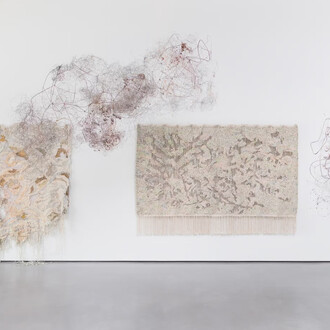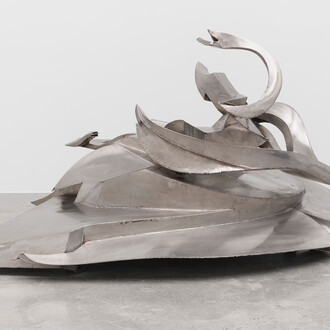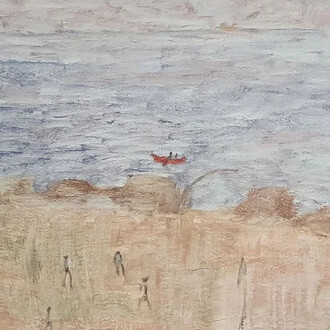Michelle Concepción, one of the artists who pioneered a technique that creates astonishing three-dimensional depth in flat, two-dimensional paintings, is exhibiting “Chaos to Order” at ArtSpace/Virginia Miller Galleries in Coral Gables, Florida.
“This exhibition is particularly interesting because it presents a selection of her work from different series over a 15-year period,” according to Virginia Miller, owner and director of greater Miami’s longest-established contemporary fine art gallery. According to the artist, “This show is actually one of the most beautiful presentations I’ve had, thanks to Virginia Miller.”
Contributing to varying interpretations of Concepción’s subject matter is their illusion. “She developed a method of painting that creates a realistic appearance of depth and texture despite the flat surfaces of her canvases or works on paper,” notes Miller. “It’s an amazing technique.”
“Pearls,” the artist’s current series of abstractions on paper, include both biomorphic forms and circular shapes reminiscent of asteroids, with deeply dimensional picture planes. Her abstractions on canvas feature biomorphic forms, but tend to be looser than her paintings on paper, with luminous backgrounds enriched by underpainting. Whether on canvas or paper, her abstractions, evocative of cellular forms or ancient asteroids, offer soft, dreamy shapes that appear to be floating in a bottomless abyss, visual meditations that invite the mind to wander among them.
According to art critic Peter Frank, “Each of us sees the myriad interplays of form, color, and shade that dominate Concepción’s paintings slightly differently, perhaps, but we all recognize that her forms float, often one across another. “Some of us are certain these shapes, whatever they are, are in motion, while others among us see them fixed in the picture, even establishing patterned rhythms.”
In the catalog for the ArtSpace/Virginia Miller Galleries’ exhibition, Frank noted that “Concepción’s art exists in a realm of expression at once more somatic and more conceptual than emotive. In this, her diaphanous plants, her floating worlds, her Magellanic Clouds-call them what you will-transport us not simply with their beauty, although they are capable of that, but with their various formal qualities. Their color, their grain, their patterning, their partial disembodiment, their suspension in some sort of fluid or humor-these and other plainly seen but not plainly felt factors conspire to commute sensations that beggar description.”
Dr. Thyrza Nichols Goodeve, author and arts educator, states that when she looks at the paintings of Michelle Concepción, “Coordinates disappear as each canvas suggests a universe in motion, where color and scale have no measure except the size of one’s imagination…. The interlocking layers of color, texture, paint, shape, and air seem to inhale and exhale into and out of one another, freed of mass or recognizable temporality.”
Both Dr. Goodeve and Peter Frank refer to “ghosts” when describing Concepcion’s paintings. Dr. Goodeve notes “The paintings are testaments or snapshots of the moment of their creation, where the shadows and specters— ghosts— which hover around them are allowed to come into view before passing away.”
The author and art critic Gerhard Charles Rump notes “how seemingly effortless Michelle Concepción has found her very own and meaningful position in contemporary painting. But it is, as always in such cases, the result of hard work, bravery—and genius.”
In his review of one of the artist’s prior exhibitions at ArtSpace/Virginia Miller Galleries, critic José Antonio Evora of El Nuevo Herald described Concepción’s paintings as an “indecipherable enigma,” adding that they are “so enveloping that one is able to be submerged in their bubbles.”
According to art historian Mayte Mari, “her paintings rely on impressions and illusions” that evoke perceptions by surfacing and disappearing. Michelle Concepción, Mari states, “seems to explore the interior of organic worlds and to make them visible – as if through a microscope” – in order to elicit a secret from their “glittering surface of endlessly changing forms.”
The art historian Sabine Krempel notes that “Michelle Concepción focuses on things that are seemingly invisible to us and makes them visible in her paintings.” Krempel adds that “The works open up a cosmos of colors, shapes, and structures… The large-format canvas works are color-intensive and powerful, while the artist emphasizes the delicate and filigree in her works on paper.”
Writing in the Naples Daily News about the exhibition “Latin American Painting Now” at the Naples (Florida) Museum of Art, JaniceT. Paine described Concepción’s painting “Over and Over 10” as “a delicate, ethereal” work. “She applies diluted pigments to a canvas that is laid on the floor, creating softly rounded translucent forms that overlap one another and seem to float weightlessly in an undefined region. Her work is haunting and beautiful. It left me wanting to see more.”
Concepción calls herself “a Puertorican-American contemporary artist, known for her experimental abstract paintings inspired by science and nature".
She describes her workplace as “more a science lab than an artist’s studio,” noting that she spends “anywhere from a couple of months to several years to complete a work” with syringes, tape, tweezers, and droppers as well as the usual brushes and mixes of paint. She calls her works “an exercise in discovery,” as she adds and subtracts layers of paint while exploring patterns, shapes and colors that weave in and out of one another.
Michelle Concepción received a Bachelor of Fine Arts degree from the School of the Art Institute of Chicago. She also studied at the University of Barcelona in Spain and the College of Art & Design (Hochschule für Gestaltung), in Offenbach, Germany. Her paintings have been exhibited since 1988 in dozens of important public and private galleries in Germany, Spain, South Korea and Hong Kong as well as in major art fairs in New York, Miami, Santa Fe, and Chicago as well as in Spain and Germany.
















